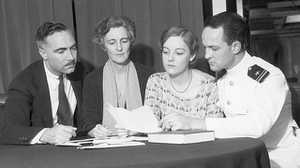Thalia Massie's Alleged Assault

Saturday night, September 12, 1931
Even though Thalia Massie and the five men charged with assaulting her were in the same vicinity, eyewitness accounts indicated that their paths did not intersect. During the time Thalia claimed the assault had taken place, the young men were involved in a minor traffic dispute on another street, observed by eyewitnesses.
As police detectives reconstructed the night's events, it became clear that Thalia Massie's story was the hardest to pin down. Her recall of details was vague, and her whereabouts for over an hour were unknown. But identifying information about the suspects, their car, and license plate number were all provided to the Massies, and soon were woven into Thalia's increasingly detailed description of her attackers.
What time did Thalia Massie leave the Ala Wai Inn?
"I left home about 9 p.m. with my husband to go to the Ala Wai Inn... Around 12 midnight I decided to go for a walk and some air." — Thalia Massie, accuser, September 13, 1931
"Q: About what time was it that you left the Ala Wai Inn?
Thalia Massie: It was about 11:35." — Thalia Massie, accuser, statement at trial, late November 1931
"We were about to leave [the Ala Wai Inn] and my husband didn't want to leave Thalia [Massie] alone, so my husband went and got Lieutenant Massie to come up and look after his wife... It must have been near 11:30. We got home before 12:00. " — Mrs. Susan Fish, Navy wife, September 22, 1931
"Q: During the evening did you miss Mrs. Massie from the party?
Thomas Massie: Yes... Between 11:30 and 12:00 -- that's as near as I can judge and on hearsay. I immediately went upstairs from where I had seen Mrs. Massie leave and made a complete search of each booth." — Lieutenant Thomas Massie, husband of accused, September 21, 1931
"I and my wife left the Waikiki Dance Hall about 12:10 p.m. Before going home, she asked me to eat noodles with her... We ordered some noodles, and while waiting for the noodles, I noticed a white woman walking down [John Ena Road] with her head bent down, and the way she walked seemed as if she was under the influence of liquor. About a yard and a half from her we saw a white man following directly in the back of her." — George Goeas, local eyewitness, September 17, 1931
"Q: Where were you from eleven o'clock on?
Alice Aramaki: I was in the barber shop [on John Ena Road]; I closed the barber shop and went in my father's store...
Q: Did you see any woman walk by the barber shop that evening?
Alice Aramaki: Yes... It was after the dance.
Q: How long after the dance?
Alice Aramaki: About 10 minutes, because the crowd was coming out."
— Alice Aramaki, local eyewitness, statement at trial, late November 1931
"Q: As you passed these stores on John Ena Road, did you notice whether they were open?
Thalia Massie: No, I didn't pay much attention to my surroundings... I think some of them were closed at that time. I remember seeing lights in one of them as I went by, but I didn't notice whether they were open or not... I was walking quite slowly, with my head down; I wasn't paying much attention."
— Thalia Massie, accuser, statement at trial, late November 1931
What time did the suspects leave the dance?
"We went to Waikiki Park... and we stayed at the dance til it got through about twelve o'clock."
— David Takai, accused, September 13, 1931
"...we went to the dance [in Waikiki Park] and we stayed to the end of the dance and we met Ben Ahakuelo and Mack [David Takai] and from there we came back to S. P. Correa's place."
— Joe Kahahawai, accused, September 13, 1931
"Q: What time did you fellows leave the dance?
Henry Chang: When the dance was over... It must be about twelve o'clock.
Q: Was is before the last dance or after the last dance?
Henry Chang: When it was over... Just after the last dance."— Henry Chang, accused, September 13, 1931
"Q: After the dance you all got in Shorty's [Horace Ida's] car?
Ben Ahakuelo: Yes... went straight home. We came to Correa's house.
Q: When you left the park, which road did you take? Did you take Ala Moana road?
"Ben Ahakuelo: No." — Ben Ahakuelo, accused, September 13, 1931
Where did the suspects go after the dance?
"My husband blew the horn, when he came to that intersection a Ford car bearing the number 58-895 coming from Liliha [Street] into King Street failed to make a boulevard stop and almost hit our car as they go into King Street... I got off the car and... the Hawaiian hit me on the left ear with his clenched fist. I staggered back, when I regained my balance I grabbed him by the throat with my left hand and struck him in the face..."
— Agnes Peoples, woman in traffic dispute, September 19, 1931"I went out of the car -- a lady came over, a Hawaiian girl, and she grabbed hold of my throat and I said what is the matter and she grab me over here (indicating) and scratch me and I shoved her off and she fell down on running board of their car." — Joe Kahahawai, accused, September 13, 1931
"...a Hudson car came speeding by and almost run in our car... Mack [David Takai] got off; from there they had argument with the other car..."
— Henry Chang, accused, September 13, 1931
"We stopped alongside the car and the woman came out and started cussing... the Hawaiian boy came out and try to shove her away and she shoved him away and they started to fight. Then there was a crowd gathering there and I told the boys, 'let's beat it,' so I drove off. "
— Horace Ida, accused, September 13, 1931
After leaving the party, when was Thalia Massie next seen?
"Mr. Bellinger said he needed some gas and drove to a gas station at King and Kalakaua, then drove back to Ala Moana Road and it was on this road we saw a woman ahead of us waving her arms for us to stop... I would judge the time we picked her up to be between 12:45 and 1 a.m."
— Mrs. George W. Clark, Sr., local eyewitness, June 22, 1932
"I fixed the time at about 1:08 a.m. when we picked [Thalia Massie] up as I looked at my watch..."
— George W. Clark, Jr., local eyewitness, June 22, 1932
How did Thalia Massie describe what happened?
"A car drove up behind me and stopped. Two men got off the car and grabbed me and dragged me into their car... They were Hawaiians... They were driving along the Ala Moana Road all this time heading towards town... They drove the car into the undergrowth on the right hand side of the road, dragged me out and away from the car in the bushes and assaulted me." — Thalia Massie, accuser, September 13, 1931
"Q: Did they drag you along the ground, or hold on to you and force you to walk with them?
Thalia Massie: They were holding me and dragging me. I didn't exactly walk; they pulled me along." — Thalia Massie, accuser, statement at trial, late November 1931
"When asked about the car these boys rode in [Mrs. Massie] said it was either a Ford or Chevrolet. She did not mention any car numbers." — George William Clark, Sr., local eyewitness, September 17, 1931
"She [Thalia Massie] said it sounded like an old car, between a Ford and a Dodge... She could not give us any number at that time." — City Detective George Harbottle, statement at trial, late November 1931
"I found Mrs. Massie in a state of collapse and weeping hysterically. She explained everything that had happened; that she had been assaulted and had been raped. She told me that she had been dragged into a car by five Hawaiians; that they had taken her to a place on the Ala Moana Road and criminally assaulted her." — Lieutenant Thomas Massie, husband of accused, September 21, 1931
"While at the Emergency Hospital (around 3 a.m. September 13, 1931)... a dispatch was broadcast from headquarters in regard to automobile 58-595 having been picked up, said number having been given by Mrs. Peeples [sic] to the police due to an argument in a near collision... Several members of the Massie party heard this broadcast..." — Office William Seymore statement, August 10, 1932
"Q: What was the license plate number, do you know?
Thalia Massie: I think it was 58-805... I just caught a fleeting glimpse of it as they drove away." — Thalia Massie, accuser, 3:30 a.m. September 13, 1931
"Q: When they grabbed you in the street you saw both Joe [Kahahawai] and Henry [Chang]?
Thalia Massie: Yes.
Q: When you were in the car, did they bend forward so you could see their faces?
Thalia Massie: Yes. They were holding me down." — Thalia Massie, accuser, September 21, 1931
Was there evidence of an assault?
"Patient came into hospital with fractured jaw and contusions and abrasions. General condition [fair], except patient quite upset following accident." — excerpt from Thalia Massie's hospital record, September 13-20, 1931
"I saw Mrs. Massie's dress... it was not rumpled and appeared to be in good condition." — Police officer George Nakea, August 18, 1932
Left Slipper
No indication to show that slipper had been dragged along ground.
Right Slipper
Shows no scraping or scuffing at all." — Police Captain of Records R. O. Griffin, September 10, 1932
"I met Lieut. Massie at the door... He told me his wife had been beaten up and assaulted. Mrs. Massie was lying on a couch near the front door. I asked her what happened. She told me that while walking along John Ena Road about two hundred or three hundred feet from Kalakaua Avenue a bunch of boys who appeared to be Hawaiians, in an old model Ford or Dodge touring car stopped alongside of her, jumped out and grabbed her and pushed her into the car and... drove down to the Ala Moana Road and... assaulted her." — Detective William Furtado, August 13, 1932.
"Dr. Thomas M. Mossman, City and County Emergency Hospital... said he examined the defendants in the Ala Moana case in relation to their genital organs and looked for evidence of traumatism, presence of blood and genital secretions... Dr. Mossman's reports of his findings are as follows:
Henry Chang: Essentially negative.
Ben Ahakuelo: Essentially negative.
Joseph Kahahawai: Essentially negative.
Horace Ida: Papular rash of glands, otherwise negative.
David Takai: Skin along raphe appears to be reddened. There are no abraded areas, lacerations or bruises." — from the 1932 Report of the Pinkerton Detective Agency







